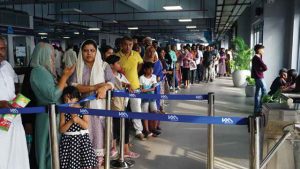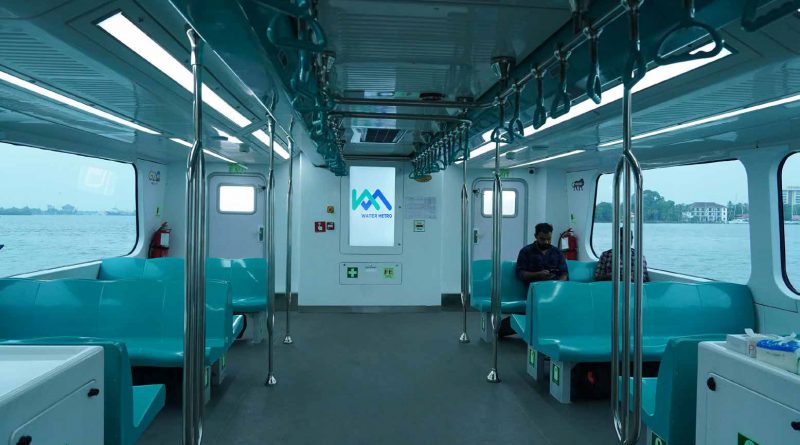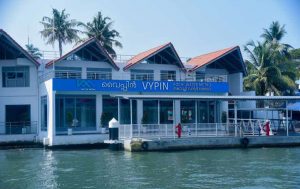The Aqua Odyssey Begins
Shaji janardhanan
Kochi is embarking on an ambitious journey towards sustainable transportation with the introduction of the Kochi Water Metro Project. This innovative initiative harmoniously merges state-of-the-art technology, environmental responsibility, and community-centered design. Poised to drastically reduce carbon emissions, the project represents a transformative step towards a greener, more inclusive future. The water transport system envisaged for Kochi focuses not only on the ferry services as the mode for public transportation but also envisions a holistic development of the areas being connected by waterways as well as integrating the waterway system as a part of the entire public transport system of the city. Apart from the ferry service development, the project also looks into developing the existing and new roads providing increased access to the jetties and also within the islands, ensuring safety and security to all its users by way of active and well lit streets, promoting use of small occupancy feeder modes to access the jetties, promoting property development around the jetties and place making. Effective use of inland waterways with the environmentally friendly hybrid boats is offering multi-fold benefits.
The various components involved in the Kochi Water Metro Project are:
- Terminals and Access Infrastructure
- Boats
- Floating pontoons
- Systems - Navigation, AFC, PIS, VCS, CCTV
- Operation & Control Centre (OCC)
- Passenger Control System (PCS
Boats
There are 78 eco-friendly boats for passenger service, 23 of them are 100 pax and the remaining 55 are meant for 50 passengers. In addition to these passenger boats, there are four numbers of Rescue cum Workshop vessels for supporting the main fleet in case of emergency and for maintenance.
Twin-screw Catamaran hull is chosen for a better stability, safety and to cater the draft restrictions and low wake properties. The objective of the boat design was to develop a boat meeting the following requirements.
Low Draft:
The estuarine condition creates a challenge for restricted depth which decreases to less than 1meters in certain stretches. The silty mud which exists in the channels poses a challenge in terms of dredging. Consider the above it was decided to achieve a draft of 0.9 meters.
Low Wake:
The backwaters in Kochi are densely inhabited by fisherman communities and traders. The waterways are used extensively for fish farming and fishing. Hence it was necessary that the boats have low wake characteristics to subdue the wake and wash effects. This will ensure protection of the shores as well
Low Energy and Environmentally Friendly:
As a huge leap into the green shipping initiative movement mooted by the International Maritime Organisation (IMO) of United Nations, the boats are electrically propelled and have no outward discharge.
The objective of the concept design led to the conclusion to adopt an Aluminum Catamaran hull,twin screw electrically propelled vessel, which will operate at a draft of 0.9 meters. The vesselsare designed to achieve a speed of 8 to 10 knots in different speed regimes with flexibility to operate under different power sources.
 Floating Pontoons
Floating Pontoons
Floating jetties adopted to facilitate embarkation and disembarkation of physically challenged elderly commuters. Concrete pontoons are being used, Pontoons are installed in the terminal waterfront where the water depths would be about -1.5 m CD to -2.5 m CD. Pontoons are connected to the terminal by means of an Aluminium gangway. The floating pontoons are provided to cater the tidal variation. Since the floating pontoons are designed with a freeboard of 0.8m in line with the freeboard of the boats, the same level will be maintained in case of tidal variations or floods which in turn will facilitate the wheel chair movement.
Features of the Terminals
Kochi Water Metro terminals are designed/ planned as a space for public gathering. Terminals are planned based on the Peak Hour Traffic (PHT). Accordingly, terminals having 1000PHT falls under major, less than 300PHT falls under minor, terminals with 300-1000PHT were considered as intermediate terminals.
All boat terminals are divided into paid and non-paid area. Ticketing facility, Ticket vending machine, Station control etc. are in unpaid area. Waiting area, Toilets etc are provided in paid area. All terminals are facilitated with Automatic fare collection and turnstile system for passenger counting.
Integrated Traffic Management System
The Water Metro has a very good communication system such as digital radio, VHF. Boats can communicate between them and also with the Port, Operation Control Centre etc. 20 CCTV cameras are placed on the boat in various critical locations, which can be seen in the Wheel House and the OCC as well. The boat is equipped with machineries to know the depth of water, speed, location of the boat ( ABLS), obstruction around the boat (RADAR), better night vision(thermal camera etc. Like in Rail Metro, automatic fare collection systems are employed as well.
Safety
Passenger Control System (PCS) has been set up in the system, which will not permit more than the allowable number of people in the boat at any given point in time. The accidents due to overcrowding is avoided.
The catamaran hull with required breadth is designed to have must better stability for the boat.
Adequate number of Life jacketsare provided at accessible locations to cater all types of people including children.
Boats and jetty are always at the same level. Passengers are not permitted to be outside of the passenger area during the trips.
Services of Workboat cum Ambulance boats will be made available to handle any emergency situation.
Well-equipped, manned Operation control Centre (OCC) has been set up to monitor movement of every boat and to attend to any exigency that may occur and to give directions to the boat.
Kochi Water Metro as a sustainable water transport
The water metro is will be made using lightweight materials such as Aluminium and FRP. This light weight will reduce resistance offered there by consume less power
The twin hull design – catamaran are designed in such a way that it will create minimum wake and thereby giving less impact to the shores.
Keep the Vembanad lake and backwaters used are the latest LTO type – Lithium Titanite Oxide which has a very long life of about 35000 cycles
These batteries are capable of fast charging and we will have fast charging stations for the boats at designated terminals. In addition to this we have incorporated EV charging stations also, for the other feeder service vehicles such as e-rikshaws. When the Water metro achieve the expected modal shift, Water Metro will reduce considerable reduction of emissions- about 44,000 tonnes of CO2 per year. This will be a huge saving as far ar the air pollution and global warming is concerned.



